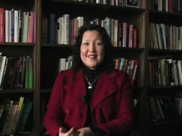“He said, “When Aboriginal people walk into a room, they are considered political. They’re just political, that’s just the way it is.” So that was one comment that I responded to, and I said, “You know, when Aboriginal people walk into the room, they’re Aboriginal people. If you choose to think of us as political, that’s something different. And that’s a general statement, it’s an assumption, it’s a stereotype…” As I was listening to him and after I made my response, I had another student on the other side of me say, “Be quiet, he has a right to say what he wants.” IVT: 8,3
“I’m trying to respond to one of his comments, because logically you respond to one racial comment at a time, if you can…And of course the girl over here is telling me to be quiet…and at one point the instructor did say, as she’s scanning the room and looking at all of us, “Is there anybody who wants to respond to this?” She was actually, the way that it was posed was that…she was just hoping and pleading that somebody respond to him.” IVT: 8,4
“I think he should have been held more accountable to the instructor. What do you say to that? “What do you mean? Do you realize that these are assumptions, do you realize that these are stereotypes, do you realize…“, something. I can probably say for sure that if the instructor thought about what she could have said, she probably would come up with better stuff than I’m saying right now, because I will grant that the instructor is aware, but I just don’t think that the instructor was comfortable with addressing it right there, and I think that should have happened.” IVT: 8,15
Before proceeding through this topic, please watch IVT: 8,3, IVT: 8,4, and IVT: 8,15.
Discussion and Analysis
In postsecondary institutions, the classroom is protected as the “instructor’s domain,” and for good reasons. Instructors’ rights to teach and discuss subject matter of their own design are an extension of academic freedom of inquiry, for both the instructor and students. And because the classroom is the instructor’s domain, there are responsibilities that go along with it. For instructors, addressing incidents that take place in the classroom is a part of this responsibility.
This student’s classroom experience illustrates why it is important for instructors to address incidents that take place in the classroom. Postsecondary institutions provide support services and resources that help students deal with the demands that are related to their postsecondary and graduate experiences; however, these resources are not typically effective in intervening in classroom incidents. Reports of these incidents may not reach these support services, as students may not take their experiences beyond the classroom due to the demands of their coursework, class schedules, and other life demands. Moreover, the student is faced with revisiting a traumatic experience while taking on the burden of responsibility to seek out resolution for a racist incident. This often results in the incident going unreported, since it can require a substantial amount of time and energy on the students’ behalf in order to see a report through to a resolution.
This student’s account describes a situation where an instructor’s response was considered inadequate, and as a result, had significant and harmful consequences to the student. In this situation, the student was forced to take on the burden of intervening in a classroom incident. She took a significant risk in responding to another student’s comments, resulting in, among other things:
- A direct confrontation with him, and with another student;
- Leaving the classroom as a result of feeling frustrated and unsupported;
- Faced with the burden of soliciting a response from the instructor;
- Anxiety over returning to the classroom;
- Alienation from the classroom and other students as the “troublemaker”;
- An inability to resume her coursework for that class;
- A troubled relationship with the instructor.
In addition to fully engaging and addressing a situation in class, it’s crucial to address an incident when it happens. As this student indicates, a situation can intensify if an instructor’s response is delayed. She points out that if the instructor had responded immediately, it may have helped to minimize the consequences for her personally and professionally, her relationship with the instructor, and for other students in the class. Of course, the question is, how to effectively intervene.
Go to Topic 3 – Workshop Materials
*Click here for a downloadable PDF version of this topic and supporting materials.


